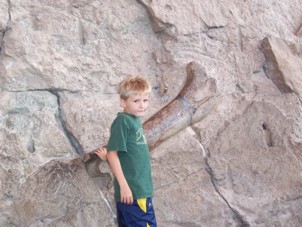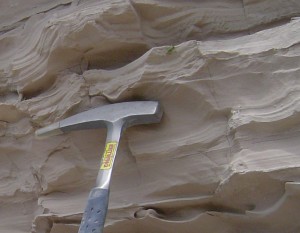 Last week I had the opportunity to participate in a workshop on Evolution and Christian Faith that is a part of the BioLogos grant program. As I noted in my last post it is always refreshing to be part of a gathering that values intellectual engagement with our faith and incorporates worship into the meeting. The chance to meet and speak with serious Christian scholars from a variety of traditions was a real highlight. At this workshop I had the opportunity to meet, and to sit down and speak on several occasions with Ralph F. Stearley, a Professor of Geology at Calvin College. Some may be familiar with Ralph Stearley as coauthor with Davis A. Young of a substantive book, The Bible, Rocks and Time: Geological Evidence for the Age of the Earth. I posted a brief introduction to this book several years ago, just after it came out, but the book is worth another look. This post is a revision of my earlier post with somewhat different emphasis.
Last week I had the opportunity to participate in a workshop on Evolution and Christian Faith that is a part of the BioLogos grant program. As I noted in my last post it is always refreshing to be part of a gathering that values intellectual engagement with our faith and incorporates worship into the meeting. The chance to meet and speak with serious Christian scholars from a variety of traditions was a real highlight. At this workshop I had the opportunity to meet, and to sit down and speak on several occasions with Ralph F. Stearley, a Professor of Geology at Calvin College. Some may be familiar with Ralph Stearley as coauthor with Davis A. Young of a substantive book, The Bible, Rocks and Time: Geological Evidence for the Age of the Earth. I posted a brief introduction to this book several years ago, just after it came out, but the book is worth another look. This post is a revision of my earlier post with somewhat different emphasis.
I have been accused on occasion, on this blog as a matter of fact, of arrogance for dismissing the young earth arguments and simply asserting an old earth as fact. I plead guilty and apologize. In my defense, it is difficult – no, impossible – to really deal with the evidence for the age of the earth in any comment or post of reasonable length. There are many different lines of evidence that lead to the conclusion that the earth is very old. The most quantitative of these point to the consensus age of ca. 4.6 billion years. It is even harder to deal with all of the arguments put forth by those defending a young earth geology. Fortunately I don’t need to lay out the evidence, or deal with the counter arguments. Davis Young and Ralph Stearley give it a great start – in 510 pages (this is not a short book).
Both Young and Stearley are geologists. Davis Young received his Ph.D. from Brown University. Ralph received his Ph.D. in Geology from the University of Michigan and is interested in paleontology and biogeography. According to the Calvin website linked above his past and present research includes studies of rock-boring marine invertebrates in the intertidal zone of the Gulf of California in Sonora, Mexico; studies of Neogene fossil fishes from western North America; anatomy and systematics of salmonid fishes; analysis of fish remains from archaeological sites in New Mexico and west Michigan; and assisting in developing a computerized database of Pleistocene mammalian fossil sites for North America. These men know what they are talking about on this subject – and they are familiar with YEC (Young Earth Creationism) arguments against the geological evidence. Thus they can, and do, engage these arguments on a scientific basis. There is no polemic in this book, just a desire to educate the interested reader.
The book is divided into four parts.
Parts 1 and 2 of The Bible, Rocks, and Time deal with historical perspectives and with biblical perspectives on the age of the earth. These sections are outstanding. I recommend them to everyone interested in the debate and how we got to the current position, especially Pastors and church leaders. Even if you don’t care about the scientific details read this.
Part 3 of The Bible, Rocks, and Time presents the evidence for the age of the earth at a relatively accessible level. This is the place to start for those who are struggling with the data. Young and Stearley begin (and 241 pages is only a beginning) to lay out the reasons why an old earth is simply a given as I approach these issues – it is not up for debate or interpretation.
Young and Stearley also put significant effort into interacting with the variety of arguments put forth by young earth creationists to account for the geological evidence. One website debunking YEC that I happened upon while preparing this post claimed that it is a waste of time to address these arguments seriously. Ridicule, the author of this site insists, is the only useful approach. Young and Stearley disagree. Ridicule is counter productive, it only serves to build walls. But none of the arguments against an old earth hold up to scrutiny. Ultimately they have no scientific credibility. If YEC is not a serious concern in your context, some of this detail may get a bit, well dare I say it, boring. On the other hand, if YEC and flood geology are serious concerns, the detail is just what is needed.
 In chapters 8-13 (about 175 pages) Young and Stearley work through much of the geological evidence for age and for a succession of eras. The stratigraphic record alone (ch. 8) provides abundant evidence for an earth that is much older than 10,000 years. The varves (cyclic deposits at the bottom of a lake, ch. 10) present in the Green River formation in Wyoming provide one of many threads of evidence for an ancient earth. Here I would like to pause an dig a little deeper.
In chapters 8-13 (about 175 pages) Young and Stearley work through much of the geological evidence for age and for a succession of eras. The stratigraphic record alone (ch. 8) provides abundant evidence for an earth that is much older than 10,000 years. The varves (cyclic deposits at the bottom of a lake, ch. 10) present in the Green River formation in Wyoming provide one of many threads of evidence for an ancient earth. Here I would like to pause an dig a little deeper.
Varves are interesting phenomena – a little like the rings of a tree, they can be very useful in both relative and absolute dating. The image above shows the very fine sedimentary layers formed in a glacial lake near Missoula MT (image from wikipedia, click on the image for a larger version). These layers represent approximately annual cycles in sedimentation. As I understand it, not being an expert in this field, there is evidence for more than one deposit per year at times due to floods and other extraordinary events, but these are relatively easy to identify and the dominant pattern is one of annual cycles. The varves not only provide a means of dating a column, they also provide information on cycles in the climate of the time.
In contrast to the 10,000 or so layers in a glacial lake such as the one in the picture above, there are millions of layers at places in the Green River formation. Thus the lakes that gave rise to these formations persisted for at least a million years or so. Of course, the lakes that gave rise to these layers also disappeared long ago. The Green River formation dates to the Eocene Epoch. Thus the layers in various cores provide ca. 0.5 million to 1.5 million year windows on the climate cycles some 50 million years ago. An interesting detail, not brought up by Young and Stearley, the varves and other sedimentary layers in the Green River formation show cycles that correlate with phenomena such as El Nino type cycles, sun spot cycles, and precessional variation of the earth (Milankovitch cycles) (J. Sedimentary Petrology 61, 1146, 1991, Geol. Soc. Am. Bull. 125, 216, 2013).
These layers and patterns are not consistent with a young-Earth. And I’ve only scratched the surface of the data discussed by Young and Stearley.
And then they get to the fun part. (I am a chemist after all.) While all the evidence points to great age for the Earth, the geological observations alone do not provide absolute dating for the various formations. This requires a turn to chemistry, physics, and radiometric dating. The field of geochronology has advanced tremendously in recent years. In chapters 14 and 15 Young and Stearley work through the basics of radiometric dating. Radiometric dating of geological features is a complex problem, one that requires a detailed understanding of geochemistry as well as the behavior of radioactive isotopes. But it is a tractable problem on a firm theoretical and experimental foundation. Young and Stearley do a good job of outlining the basics for a non-scientist. The physical arguments that are raised against the accuracy of radiometric arguments simply do not hold up. But independent of the strength of the evidence, it is important to bear in mind a point that Young and Stearley make at the beginning of chapter 14:
The claim that radiometric dating is the only support for the ideal that Earth is old is not valid. As a result, attempts to discredit radiometric dating are pointless if the goal is to support the notion that Earth is really young. Long before the development of radiometric dating methods, there was abundant geological evidence for an ancient world. Even is young-Earth creationists could somehow discredit all radiometric dating methods, the conclusion that Earth is very old is firmly established on solid scientific grounds such as those we laid out in the preceding chapters. What would be lost if radiometric dating were totally invalidated would be a more accurate determination of the age of Earth and of geologic events. (p. 389)
The layers in the Green River Formation have been dated rather precisely using 40Ar/39Ar ages – a radiometric method. In one core with sedimentary layers (although not technically varves) the ages range from 49.92 ± 0.10 Ma to 51.40 ± 0.21 Ma … that is the most recent layer dated is 49.92 million years old give or take a hundred thousand years and the oldest layer is 51.4 million years old give or take 210 thousand years. Intermediate layers fall in succession between these two. Thus the column represents a record spanning 1.5 million years. If these ages were invalidated the formation would still indicate great age, we would only lose the ability to perform the more detailed and quantitative analyses.
The final section (Part 4) of The Bible, Rocks, and Time discusses some philosophical perspectives on the problems that young-Earth creationism introduces into the church as they, speaking as professional geologists, see it. All professional Christian scientists – and Young and Stearley make this point – know many who were shipwrecked without intellectual resources for faith when confronted with the depth of the evidence. The confrontational either-or shape of the dialog (that is, either young earth or no God) often promoted by both young-Earth creationists and by many evangelistic atheists alike serves the church ill. The data presented in last week’s post Faith and Vocation as a Scientist provide a window on the effect this conflict is having, if not yet on the general population, at least on those who are going on to educate the next generation in our colleges and Universities.
If the questions surrounding the age of the earth are an issue in your surrounding, this book is an excellent resource to have on hand.
What will it take to move the church away from young earth creationism?
What evidence is convincing?
If you wish to contact me directly you may do so at rjs4mail [at] att.net.
If interested you can subscribe to a full text feed of my posts at Musings on Science and Theology.











